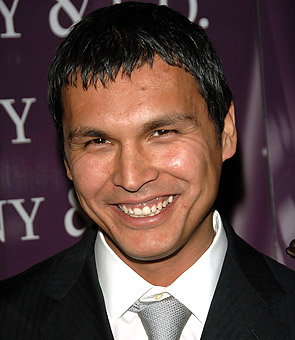Home |
Contents |
Photos |
News |
Reviews |
Store |
Forum |
ICI |
Educators |
Fans |
Contests |
Help |
FAQ |
Info


Stereotyping Indians by Omission

Tribal leaders and opinion leaders in Indian country often complain about the depiction of their peoples and issues in media. Often this means, the lack of depiction, as one of the major problems is invisibility of Indian faces in media.
Media Impact on American Indian Public Policy Is Important Strategic Key, Indian Country Today, 1/9/06
*****
No contemporary Indians
From the Journal News, 5/29/01:
Media foster stereotypes about Indians
Much has been written about Indian mascots and stereotypes but the problem is far more extensive than most people realize. Many misconceptions may be attributed directly to the media which, despite superficial attempts to be politically correct, continues to perpetuate stereotypes and fails to recognize our indigenous population as a part of modern American society.
Occasionally a quality film or TV show has focussed on contemporary Indians but always in a Native American setting or dealing with specifically Indian issues. Hallmark Hall of Fame's "The Lost Child" and TNT's "Lakota Woman" are good examples. "Thunderheart" gave an overview of the crisis at Pine Ridge Reservation during the early 1970s. Although films such as "Geronimo" and "Crazy Horse" have their place, the only population to be portrayed far more often in historical context than as contemporary people, are the Indians.
With over 40,000 Indians living in and around New York City, one might wonder why there is never a Native attorney or police officer on "Law and Order" or "NYPD". They haven't even had an Indian perpetrator. With the size of Chicago's Native population, it is surprising that not one Indian ever received emergency care in "E.R." or was ever treated at "St. Elsewhere". Not one medical show has ever had an American Indian doctor. And where are the Indian nurses; a primary career choice for many native women? Countless Indian teachers are working in schools across the country but they, too, are invisible in the media. Native programmers, firefighters, auto mechanics, pilots, ranchers, shopkeepers, and secretaries never seem to make it into the plots of our routine TV or big screen fare.
This is not because of a lack of resources. There are many fine native actors, some of whom are extraordinarily talented. They can easily portray any of the contemporary generic roles from romantic lead to evil villain. Unfortunately, they are often relegated to waiting for a role where they may don their buckskins and feathers in period productions. And if they are shown in a modern setting, the plot is all too often either based on some variation of the tribe protecting their land from nuclear waste, unscrupulous miners, or some other kind of evil doers. Another overused story line equates Indian beliefs with the occult or fantasy. The plots become more and more trivial and predictable because no one has bothered to focus on the realities of who Indians are.

Even on the documentary front, the ignorance is astonishing. When it was suggested that A&E "Biography" include some contemporary Indians in their programming such as Wilma Mankiller (recently retired principal chief of the Cherokee), Dennis Banks (co-founder of the American Indian Movement and a leader of the 71 day siege at Wounded Knee in 1973), world renowned artist Alan Houser, or Colorado's Senator Ben Nighthorse Campbell, their response was that they determine their programs by name recognition. The most recent Indian A&E has recognized was Will Rogers (1879-1935). Canada is so far ahead of us. There, CBC has already had two popular regular series based on Indian characters and Indian documentaries and other shows are fairly common.
Almost every ethnic group has been portrayed in some type of stereotypical fashion by the media. Shows like the "Fighting Fitzgeralds", "The Sopranos", and many of the African American sitcoms often show stereotyped behavior. Asians are far too often shown, merely, as martial arts experts and Latinos, too are rarely shown realistically. The primary difference in our reaction to these portrayals comes from the fact that most of us know people from these ethnic groups. They are our friends and neighbors and we are, therefore, able to recognize the stereotypes when we see them. It is also quite possible that we have Native American acquaintances but we are rarely aware of it. As a hidden minority neither their appearance nor their names may indicate their heritage but thousands of them are living here among us. Therefore, our only frame of reference, when we think of Indians, are the stereotypes forced upon us by the media.
Eliminating Indian mascots is only a first step in the effort to resolving this form of racism. We must recognize that Indians are a significant, vibrant, part of contemporary American culture and not ghostly relics from the past nor strange sects practicing odd rituals. The American Indians have moved into the 21st Century. The media has yet to do so.
Rob's comment
A correspondent notes that actor Benjamin Bratt played a police officer on TV. As reported in the LA Times, 6/13/04:
Bratt always identified as an underdog and that feeling is with him still. Growing up, he recalls, his family was on welfare and, while studying at San Francisco's American Conservatory Theatre, he drove a Super Shuttle to make ends meet. The son of a Peruvian Indian mother who came to the U.S. at 14 and an English-German father, he participated in a takeover of Alcatraz Island at age 5.
Though he embraces Native American culture, he's primarily been cast as Latino in movies such as "Bound by Honor" (1993) and "Piρero" (2002), a breakthrough role in which he portrayed the famed poet-playwright. As Jerry Orbach's partner in "Law & Order" from 1995 to 1999, he was "NBC's answer to Jimmy Smits" of "NYPD Blue," a critic observed.
Other Natives as nontraditional cast characters include Stepfanie Kramer (Hunter), Michael Horse (Twin Peaks, Roswell), Graham Greene (Wolf Lake), Marie Cheatham (soap operas), and Jonathan Winters. Natives in traditional or guest-starring roles are slightly more common, but the numbers are still small.
In 2007, Adam Beach joined the cast of Law & Order: SVU. It's another step forward, but this kind of casting should happen several times each year, not once every ten years.

Indians ignored every day but one
From the Baltimore Sun:
Reach out to American Indians the other 364 days of the year
By Andrew L. Yarrow
November 22, 2007
Inevitably and sadly, Thanksgiving is the one day of the year when American Indians cross the minds of most other Americans. Other than at our yearly commemoration of Pilgrims and Indians giving thanks, in early elementary school, in occasional movies or as tourists in the Southwest, most Americans give about as much thought to and have as much knowledge of their country's first inhabitants as they do the people of Outer Mongolia. This needs to change.
While America's 298 million non-Indians generally express good will and considerable sympathy about past injustices and present poverty afflicting Indians, they largely view the nation's Indians as relics of a past that ended with Custer and Wounded Knee. Or, because of lack of knowledge, they frequently see them through a caricatured and stereotyped lens forged on old Hollywood back lots. For the most part, they are oblivious to the vibrancy and difficulties of present-day Indians' lives and culture, or to their social and legal status, a recent study of non-Indians' thinking about American Indians by Public Agenda has found.
Despite some recent, politically correct romanticizing of Indians as spiritual, and model environmentalists, to most Americans, knowledge and thinking about Indians begin and end with Pocahontas and Sacajawea (good) and half-formed notions about primitive savages and alcohol-riddled reservations (bad).
The good news, according to the report, "Walking a Mile: A First Step Toward Mutual Understanding" one of the most exhaustive attitudinal studies ever done on this subject is that non-Indians want to be better informed about Indian life today and in the past. (Indians, also surveyed, strongly second that sentiment.) The bad news is that there is very little public education about America's native people out there.
After centuries of post-1492 microbial and military decimation, and further generations of discrimination, Indians largely have vanished as historical actors on the U.S. stage, at least in the minds of most non-Indians. When asked what comes to mind when they think of Indians, many non-Indians ticked off such images as teepees, wampum, warriors, casinos and alcohol. They picture Indians as "stoic," "brave," "fierce" or "spiritual," sporting ponytails and wearing exotic dress and jewelry.
Although two-thirds of America's Indians live in urban areas, and only a half-million inhabit reservations, in non-Indians' minds, Indians exist only on "the res." This perception flows into one of poverty, unemployment and social pathology. Nevertheless, many non-Indians particularly those who live close to Indian populations resent the perceived "preferential treatment" and "loopholes" to establish profitable casinos that Indians receive, and are opposed to large-scale public funding.
Indians are painfully aware of their invisibility and bitterly resent the stereotypes and ongoing sub rosa prejudice against them. Contrary to non-Indians' beliefs that Indians are coddled by the U.S. government, the Public Agenda study found that many Indians feel that they are still victims of government policy, and that supposed governmental largesse is actual public stinginess. They also sense an ongoing devastation of their culture, symbolized by such diverse phenomena as using Indian land in Washington state for the Hanford nuclear-waste reservation to portrayals of Thanksgiving and Columbus Day as holidays implicitly celebrating the subjugation of Indians.
Although Indians believe that much needs to be done to redress widespread poverty, unemployment, poor health and low educational attainment, they are also proud of their cultures and justifiably prickly about unawareness of their successes in professional, urban, middle-class America. Yet, even there is a rub: Many Indians feel they straddle two worlds, torn between their historic cultures and modernity, and between identities as Indians and as Americans.
Clearly, more sophisticated education about Indian life is needed. It should not be relegated to third-graders. And memory should not be left to the fourth Thursday in November. It should be integrated into curricula throughout high school and college. Media and popular culture need to do more thoughtful portrayals, and not simply report on Indian crime and substance abuse, or continue to craft dramas with either old, disparaging or new, flattering stereotypes.
The lives of urban and other non-reservation Indians, many successful, need to be showcased. Museums, too, need to go beyond natural-history-cum-anthropological displays that reinforce the notion that American Indians are a dead culture, denizens of pre-1890 America and improve upon potentially outstanding institutions such as the National Museum of the American Indian.
As a starting point, as one Indian said, "Maybe you should just tell them that we still exist."
Andrew L. Yarrow is vice president and Washington director of Public Agenda, a nonpartisan think tank, and a professor of U.S. history at American University.
More on stereotyping Indians by omission
"Real America" = white?
No Natives in (Lil) Green Patch
Natives not on Canada's list
Omissions send a message
Natives are still invisible
Related links
TV shows featuring Indians
The best Indian movies
Native comic strips vs. comic books
* More opinions *
|
|
. . .
|

|
Home |
Contents |
Photos |
News |
Reviews |
Store |
Forum |
ICI |
Educators |
Fans |
Contests |
Help |
FAQ |
Info
All material © copyright its original owners, except where noted.
Original text and pictures © copyright 2007 by Robert Schmidt.
Copyrighted material is posted under the Fair Use provision of the Copyright Act,
which allows copying for nonprofit educational uses including criticism and commentary.
Comments sent to the publisher become the property of Blue Corn Comics
and may be used in other postings without permission.



